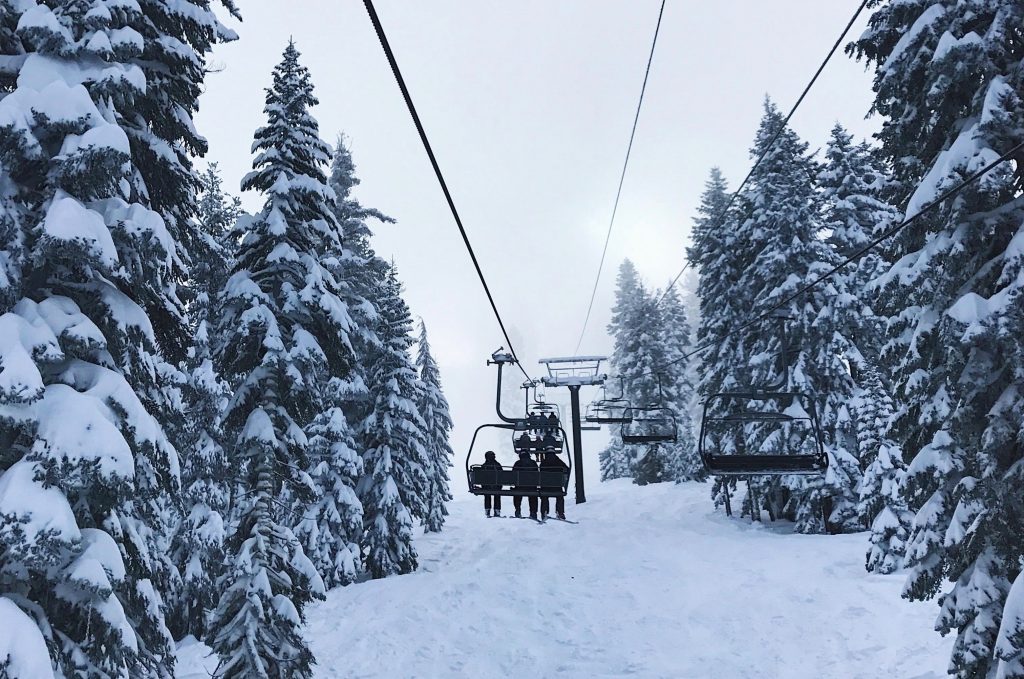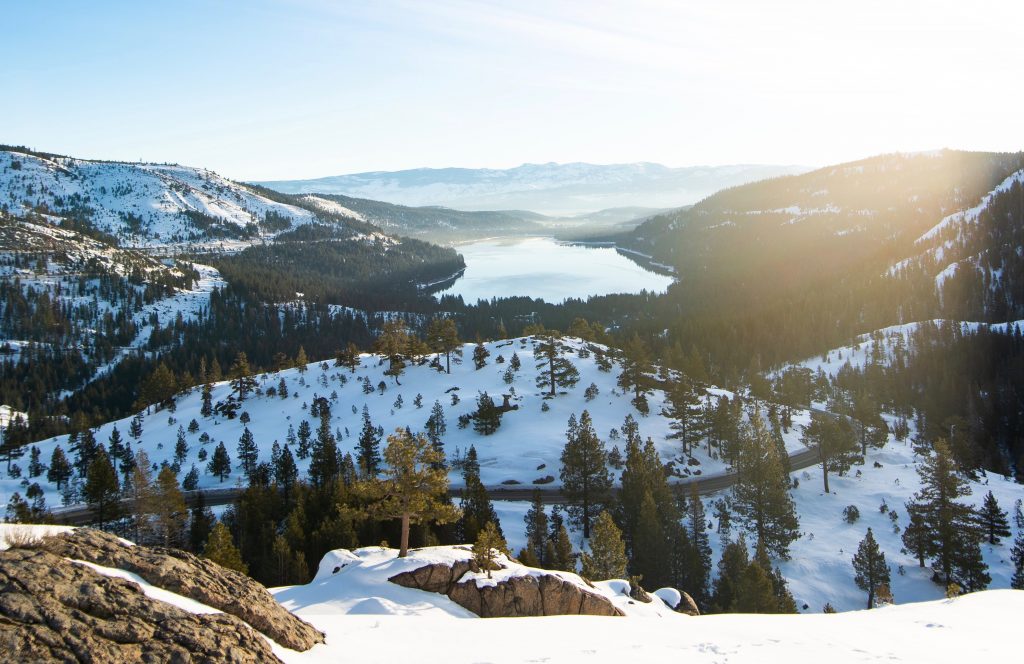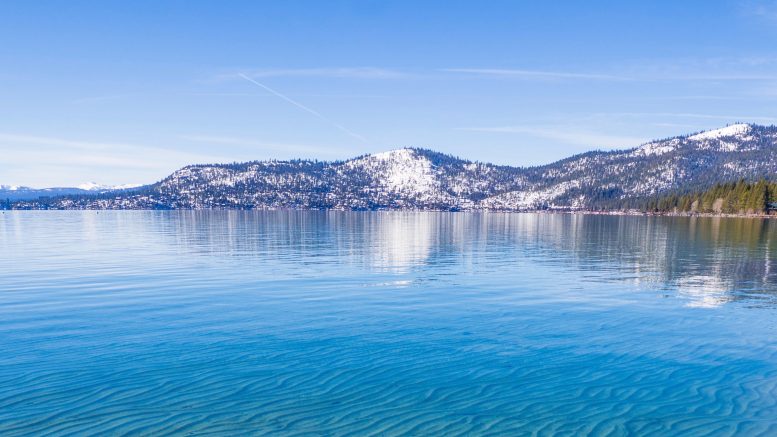Unless mitigation measures are followed, all but one host city will be too warm for games
By Frank X. Mullen
A new climate change analysis concludes that the Lake Tahoe area is already too warm to risk hosting the Winter Olympic Games there again, but those who have been working to have the event return to the Sierra aren’t sounding the death knell for the region’s winter sports just yet.
“A lot of people have done years of work in this region to see if another winter games would be feasible,” said Jon Killoran, CEO of the Reno-Tahoe Winter Games Coalition. “This study would be another piece that would be taken into account. As you look at the entire picture, studies are what they are – a glimpse into a possible future. Then it’s a matter of what people do about what those ramifications are, to either mitigate them or not.”
Killoran noted that predictions aren’t carved in stone. Even if the Sierra resorts never catch the Olympic rings again, he said, the region remains a training ground and will continue to host world-class winter sports events.
“(The coalition) has staged and will continue to stage events both in northern and southern Nevada that bring social, economic and other benefits to the state,” he said. “We’re finding a future regardless of an Olympic Games bid. And we continue to monitor any and all things that come forward in regards to a future bid.”
According to the study by an international team of researchers at the University of Waterloo in Ontario, Canada, the effects of climate change will keep the resort that hosted the 1960 Winter Games out of the running for future Olympics. That resort — then called Squaw Valley; renamed Palisades Tahoe — is no longer a dependable candidate as a venue.
Fewer storms, soggier snow
Choosing a site for the Winter Games has always come with a risk factor. At Squaw Valley in 1960, drought conditions prevailed. Days before the event began, Native Americans staged a snow dance and crews seeded the clouds with silver iodide crystals. Just in time, a storm dumped 7 feet of powder on the Sierra and let the games begin. At Lake Placid in 1980, workers frantically shoveled truckloads of snow onto rocky cross-country ski trails before those events could start. The 2022 Winter Olympics in Beijing, now in progress, is the first Winter Games to use almost entirely artificial snow.
Picking a site and expecting the weather to cooperate has never been a sure thing, but climate change, accelerated by man-made CO2 emissions, has further stacked the deck against potential venues.
At Lake Tahoe, weather patterns have shifted; snowfalls in February have decreased. Climate models predict that with continued high CO2 emissions, in another 30 years Palisades Tahoe will be too warm to host the winter sports events. The analysis indicates that by mid-century an estimated 50% to 89% of the area’s February days will have insufficient or wet snow and 25% to 50% of days will be too rainy or warm for competition. By 2080, it will be unreliable as a venue nearly 90% of the month, according to the study’s predictions.
“The world of winter sport is changing as climate change accelerates, and the international athletes and coaches we surveyed are witnessing the impacts at competition and training locations, including the Olympics,” said Daniel Scott, a professor of Geography and Environmental Management at the University of Waterloo.

Historical facts; models of the future
The researchers studied historical climate data from the 1920s to the present, and examined future climate change scenarios for the 2050s and 2080s. They also surveyed international athletes and coaches and found that 89% felt changing weather patterns are affecting competition conditions, and 94% worry that climate change will impact the future development of their sport.
The research team found that the average February daytime temperature of host cities has steadily increased more than 10 degrees during the last century – from 32.7 °F in the 1920s until the 1950s, to 43.3°F in the first half of this century, including in Beijing. Using that data, the team assessed the likelihood that each site would have below-freezing nighttime temperatures and at least a foot of snow, either natural or manmade.
In 80 years, the researchers predicted, only one former Winter Olympics site, the Japanese city of Sapporo, will have enough snow to host the Games. But if the Paris Climate Agreement emission targets can be achieved, the researchers noted, seven other previous host cities may still be considered “reliable” venues: Salt Lake City, Lake Placid, Vancouver, Calgary, Lillehammer, Oslo, and Nagano.
But even with mitigation measures in place, and snow-making technology widely available, researchers concluded that Palisades Tahoe would still be too warm for the Winter Games.
First U.S. venue
The 1960 Winter Olympics at Squaw Valley/Palisades Tahoe was the first held on U.S. soil. Other American venues followed, with Lake Placid, NY, in 1980 and Salt Lake City, UT, in 2002, when Reno-Tahoe interests also had bid to host the event. The local coalition to get the games back in the Sierra was revived and built momentum in the early 2000s.
“(The coalition), starting in the early 2000s, was pursuing the opportunity to bid for 2010, 2014, 2018 and 2022,” said Killoran, who explained that the U.S. Olympic and Paralympics Committee chose not to pursue Olympic Games bids for those years. “… So we were always in a position of preparing to bid if a bid were to take place. But no bids ever took place until November 2019.”
That year, the Olympic Committee offered Reno-Tahoe, Denver and Salt Lake City a chance to compete to be the next preferred U.S. Winter Games venue. Killoran said Reno-Tahoe didn’t take part in that process, because no specific Olympic year was attached to the offer and “we weren’t comfortable with that.”
Salt Lake City won the opportunity to be the preferred site the next time the Winter Games are held in the U.S.
Prior to the University of Waterloo’s report, there were plenty of studies predicting the dire consequences of climate change in the Lake Tahoe Basin. Annual snowfall has decreased over the decades and droughts have become more common. The lake now falls below its natural rim – which cuts off the flow that feeds the Truckee River – sooner and more frequently than it used to.
Infrequent snowstorms
Scott Sady, a Reno photographer who has skied and raced at Sierra resorts for decades, said anyone who takes part in winter sports around Lake Tahoe knows the trend toward drought and shallower snow depths is ongoing.
“I don’t need a study to tell me that it is getting warmer,” Sady said. “We can almost never ski the Davis Creek park run anymore, and if we can, it is for maybe a couple weeks each year… I started racing because of that seven-year drought where you could only find manmade strips of snow in January. Before that I pretty much never even bothered to ski a groomed run. Then, for about 5 or 6 years of record below-average snowfall, that was all you could ski.”
Sady said that “all our precipitation (now) seems to come in just a couple of giant storms. It used to be you would get 6 inches here, a foot there. Now it’s 10 feet, then nothing. After this massive Christmas storm all my friends were talking about what a great snow year it was going to be and I told them, you wait, it probably won’t snow for the next two months. Looks like I may be right given the long range forecasts.”

Dryer winters, rocky runs
The snow line is getting higher over time, he noted.
“This was on stark display around four years ago, when almost every storm came in with a snow level above 8,000 feet,” Sady said. “Mt. Rose had snow and the entire lower mountain at Squaw and Alpine were dirt, in the middle of winter… I noticed a ton of regular Squaw skiers all of a sudden had Mt. Rose passes the next year because you could see the writing on the wall. Even if it snows, it may still be raining at Squaw since it starts around 6,800 feet.”
Sady doubts that the Palisades Tahoe, Alpine and Northstar resorts can continue to operate on natural snow for more than another decade or two. “Given all the money (the resorts) are putting into their villages and real estate, that could turn out to be a huge issue,” he said.
A training powerhouse
Although the recent study centered on Palisades Tahoe because it was the site of a previous Winter Games, Killoran noted that the events have gotten so extensive no one resort can possibly be the sole venue anymore. “It would take a number of resorts,” he said.
Sierra resorts have been a premier training area for Winter Games athletes, Killoran said, and that will continue no matter where future games are held. More than a dozen athletes now competing in the 2022 Winter Games in Beijing trained at ski areas around Lake Tahoe and Truckee, CA.
And other important winter sports competitions will continue to be scheduled at Lake Tahoe.
“Climate studies come out from time to time and we’re basically seeing the same (predictions),” Killoran said. “When it comes to climate change, it’s up to all of us, local, regional, national or worldwide, whether these things will actually happen and whether they can be mitigated.”


Be the first to comment on "Study: global warming eliminates Tahoe as Olympic venue; boosters remain optimistic about winter sports"